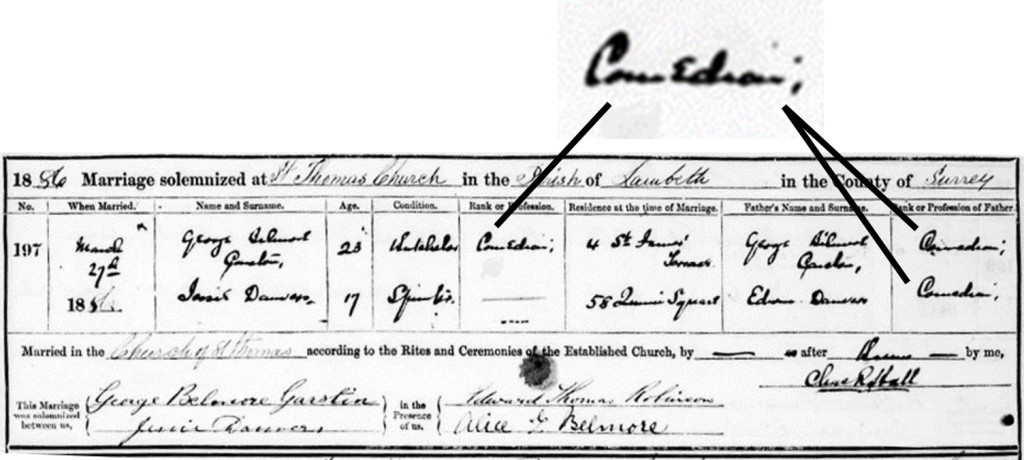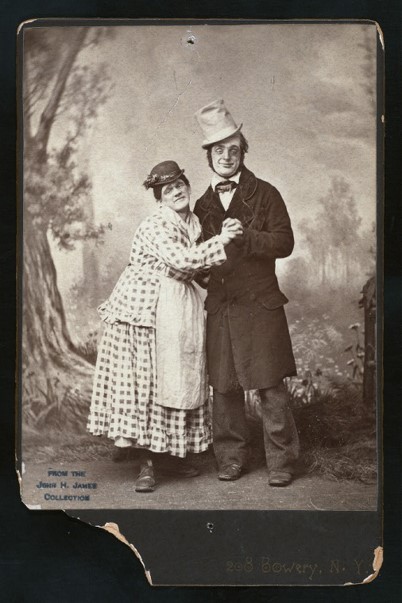Whilst of course not every performer comes from a family of like-minded performers, there are remarkable examples of families where successive generations tread the boards. Names such as Redgrave, Cusack and Fox spring to mind – where the talent is passed on through the generations: parents, children, grandchildren, greats … We may be less familiar with the names Belmore, Garstin and Danvers but had we been theatre aficionados a century or so ago, these names would be well-known. They include Alice Esther Garstin, former pupil of RMIG in the late C19th, who took the stage name Alice Belmore.
Alice was the daughter of George Belmore Garstin and Jessie nee Danvers. As can be seen from Alice’s parents’ marriage certificate, in 1886 there were already at least two generations of performers.


(bottom row) the generation before them: Edwin Danvers and George Benjamin Garstin (professional name George Belmore)
The grandfather of George (Senior) was James Card who was a stage director so theatre was decidedly in the blood. George married Alice Maude Mary Ann Cooke and of their seven children at least five became actors. George (Junior) and Jessie nee Danvers had five children, of whom four were actors including our former pupil.
Alice is sometimes recorded as Alice Esther Garstin, sometimes as Alice Belmore Garstin. Her petition as a prospective pupil, for example, refers to her as A B Garstin (A14831 GBR 1991 RMIG 3/1/1/10 Petition 1937). It later becomes even more confusing over names as we will see.
Alice was the second born child of Jessie & George. Sadly Jessie was to see three of her children die before she did. When George Belmore Garstin died fairly young, his daughter became eligible for a place at RMIG but, like all other pupils, had to undergo the same procedure for admission. Whether appeals such as the one below is flouting the system is a moot point. It clearly had an effect as another piece just three weeks later indicated that the same person wished to thank everyone who had responded to the appeal and announced that Alice had been accepted.
Alice’s sister Jessie did not become a pupil. It is not known why as she was of the right age but perhaps the rule about no sisters being pupils at the same time was at that point riding high. There were frequently cases of sisters in school at the same time despite the mid-century ruling. If ‘no sisters’ seems cruel, it was based on the view that masonic largesse should be more widely spread as there were always more prospective pupils than places available, despite the constant expansion in buildings and facilities. Another possible reason is that her mother remarried (an actor, of course!) and was thus able to provide for her daughter. The one rule that was rarely, if ever, broken was that pupils had to be daughters of indigent freemasons who were, through death, disease or disaster, unable to provide for those daughters. As Jessie (Junior) had a home with her mother (Jessie Senior) and stepfather, Gilbert Heron, she may not have qualified as indigent whereas Alice, already at the School, could remain as a pupil on the basis that it would be unfair to inflict further change on ‘the little ten-year-old daughter of the late George Belmore’.
Of Alice’s time at school we know very little. She was clearly in school in 1901 as she appears there in the census of that year. She left in December 1904 or possibly early in 1905 (two different entries so two different dates) to teach in a family at Maidenhead. Clearly, despite her lineage, the acting profession was not deemed suitable by the School. In the Archives is a book of pupil teachers and mistresses which includes where they went after leaving the school. Most have entries such as ‘left to be married’ but one has the comment ‘left to go on the stage’. The disapproval is palpable!
In 1912, Jessie visited the school on ex-pupils’ day and signed the visitor’s book as Alice Huntley nee Garstin. She remained in touch with school as her name & address appear in Massonica May 1916 under the name Huntley. In actual fact, she married in 1909 Victor Claude Rayment (sometimes known as Huntley) and in 1910 their son Victor Montague Huntley Garstin Rayment was born. Just to add confusion to puzzlement, in the 1911 census, Victor C Huntley completes and signs the census form but is not actually there on census night. Alice is there with her baby son and uses the name Huntley.
As far as the school was concerned, they may have thought they had placed her with a family in Maidenhead but Alice had other ideas. In 1905, the year she left school, she appeared in Back to the Land at the Savoy Theatre
‘… she went on to appear in a series of successful productions at London’s Lyceum Theatre, mounted by Walter and Frederick Melville … [who] were authors and producers in many of London’s Victorian and Edwardian theatres including The Lyceum in the West End. Alice’s biggest Lyceum successes included The Monk and the Woman, and Women and Wine, both produced in 1912. Alice Esther went on to play Mercedes in Monte Cristo in 1913, and Lucy in Her Forbidden Marriage, 1915. In later productions Alice worked with her step-father, her mother Jessie’s new husband Gilbert Heron.’ http://belmore.altervista.org/alice-esther-belmore

Alice appeared in a wide range of theatre productions from melodrama to Shakespeare. She was almost invariably described as ‘charming’. A review (in The Truth) of 1915 made a point about the quality of the material without denigrating the young actress.
Alice often appeared with other members of her family – to wit the cast list for Robinson Crusoe with George Belmore (Alice’s brother) also listed. There were also film roles with the British Empire Films Company.
‘From around 1915 Alice was in a string of films produced by Frederick Melville’s production company in their London Studios of the time’ http://belmore.altervista.org/alice-esther-belmore
British Empire Films, started by Frederick Melville, employed Alice as a star actress in the company. The British film industry was still a minnow compared to the American film industry but it was very popular with British audiences prior to the outbreak of The Great War. The Melville Brothers were prolific playwrights, which plays they would stage at the Lyceum (of which they had joint proprietorship). They were particularly known for what became termed ‘bad women dramas’ concerning inevitably beautiful maidens who make the wrong life choices or cause problems for themselves and others. Titles included The Monk and The Woman, Her Forbidden Marriage or The girl who took the wrong turning.

Sadly, whether Alice’s film career would have taken off is unknown. In 1919, she died aged just 29.
In her death is another mystery. She is quite clearly referred to as Mrs John Mack and the In Memoriam column of the following year (29 January 1920) includes
In this is the clear understanding that, at the time of her death, Alice was married to John Mack, another performer, who trod the boards in a double act Ferguson & Mack.

It is unclear whether this was an ‘official’ marriage as stage names and ‘real’ names vary so much it is unknown under which name the couple may have married, if they actually did. However, it might underpin the view held by family members that Alice died as a result of an abortion. If she and John Mack were man & wife in name if not in the eyes of the law, it might not be appropriate to bring a child into the world whose legitimacy could be questioned. This is firmly in the realms of speculation of course. Victor Rayment, the person to whom Alice had been married in 1909, was known to be touring across Canada and later moved to America. He remarried in 1919 so perhaps the marriage had failed, new relationships had been formed but not authorised. The fact that Victor remarried almost immediately after Alice’s death may give a bigger clue than is at first apparent.
Ferguson & Mack were popular comedians and had been working the music halls for many years. It is perhaps fitting that Alice was born as the daughter of one comedian and she appeared to depart this life as the wife of another.
Material from http://belmore.altervista.org/alice-esther-belmore has been used with kind permission.




